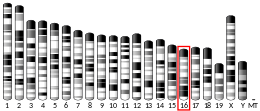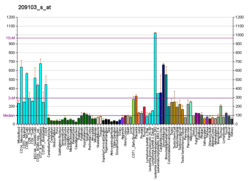UFD1L
Ubiquitin fusion degradation protein 1 homolog is a protein that in humans is encoded by the UFD1L gene.[5][6]
Function
The protein encoded by this gene forms a complex with two other proteins, NPL4 and VCP, that is necessary for the degradation of ubiquitinated proteins. In addition, this complex controls the disassembly of the mitotic spindle and the formation of a closed nuclear envelope after mitosis. Mutations in this gene have been associated with Catch 22 syndrome as well as cardiac and craniofacial defects. Alternative splicing results in multiple transcript variants encoding different isoforms.[6]
Interactions
UFD1L has been shown to interact with NPLOC4.[7][8]
gollark: The horse contains code, and is not an emergent property of anomalous cellular automata embedded in Discord infrastructure?!
gollark: <@231856503756161025> Instead of SRV records, I could also do horrible DNS things to return different A(AAAA)/CNAME records.
gollark: This does sound like an actual mental health problem of some kind.
gollark: What of your previous unfinished games?
gollark: It temporarily became sentient, for purposes.
References
- GRCh38: Ensembl release 89: ENSG00000070010 - Ensembl, May 2017
- GRCm38: Ensembl release 89: ENSMUSG00000005262 - Ensembl, May 2017
- "Human PubMed Reference:". National Center for Biotechnology Information, U.S. National Library of Medicine.
- "Mouse PubMed Reference:". National Center for Biotechnology Information, U.S. National Library of Medicine.
- Pizzuti A, Novelli G, Ratti A, Amati F, Mari A, Calabrese G, Nicolis S, Silani V, Marino B, Scarlato G, Ottolenghi S, Dallapiccola B (August 1997). "UFD1L, a developmentally expressed ubiquitination gene, is deleted in CATCH 22 syndrome". Hum. Mol. Genet. 6 (2): 259–65. doi:10.1093/hmg/6.2.259. PMID 9063746.
- "Entrez Gene: UFD1L ubiquitin fusion degradation 1 like (yeast)".
- Botta A, Tandoi C, Fini G, Calabrese G, Dallapiccola B, Novelli G (September 2001). "Cloning and characterization of the gene encoding human NPL4, a protein interacting with the ubiquitin fusion-degradation protein (UFD1L)". Gene. 275 (1): 39–46. doi:10.1016/S0378-1119(01)00649-7. PMID 11574150.
- Lass A, McConnell E, Fleck K, Palamarchuk A, Wójcik C (August 2008). "Analysis of Npl4 deletion mutants in mammalian cells unravels new Ufd1-interacting motifs and suggests a regulatory role of Npl4 in ERAD". Exp. Cell Res. 314 (14): 2715–23. doi:10.1016/j.yexcr.2008.06.008. PMID 18586029.
Further reading
- Maruyama K, Sugano S (1994). "Oligo-capping: a simple method to replace the cap structure of eukaryotic mRNAs with oligoribonucleotides". Gene. 138 (1–2): 171–4. doi:10.1016/0378-1119(94)90802-8. PMID 8125298.
- Suzuki Y, Yoshitomo-Nakagawa K, Maruyama K, Suyama A, Sugano S (1997). "Construction and characterization of a full length-enriched and a 5'-end-enriched cDNA library". Gene. 200 (1–2): 149–56. doi:10.1016/S0378-1119(97)00411-3. PMID 9373149.
- Novelli G, Mari A, Amati F, Colosimo A, Sangiuolo F, Bengala M, Conti E, Ratti A, Bordoni R, Pizzuti A, Baldini A, Crinelli R, Pandolfi F, Magnani M, Dallapiccola B (1998). "Structure and expression of the human ubiquitin fusion-degradation gene (UFD1L)". Biochim. Biophys. Acta. 1396 (2): 158–62. doi:10.1016/s0167-4781(97)00211-x. PMID 9540831.
- Yamagishi H, Garg V, Matsuoka R, Thomas T, Srivastava D (1999). "A molecular pathway revealing a genetic basis for human cardiac and craniofacial defects". Science. 283 (5405): 1158–61. doi:10.1126/science.283.5405.1158. PMID 10024240.
- Hartley JL, Temple GF, Brasch MA (2000). "DNA cloning using in vitro site-specific recombination". Genome Res. 10 (11): 1788–95. doi:10.1101/gr.143000. PMC 310948. PMID 11076863.
- Botta A, Tandoi C, Fini G, Calabrese G, Dallapiccola B, Novelli G (2001). "Cloning and characterization of the gene encoding human NPL4, a protein interacting with the ubiquitin fusion-degradation protein (UFD1L)". Gene. 275 (1): 39–46. doi:10.1016/S0378-1119(01)00649-7. PMID 11574150.
- Amati F, Conti E, Botta A, Amicucci P, Dallapiccola B, Novelli G (2002). "Functional characterization of the 5' flanking region of human ubiquitin fusion degradation 1 like gene (UFD1L)". Cell Biochem. Funct. 20 (2): 163–70. doi:10.1002/cbf.966. PMID 11979512.
- Amati F, Condò I, Conti E, Sangiuolo F, Dallapiccola B, Testi R, Novelli G (2003). "Analysis of intracellular distribution and apoptosis involvement of the Ufd1l gene product by over-expression studies". Cell Biochem. Funct. 21 (3): 263–7. doi:10.1002/cbf.1021. PMID 12910480.
- Ye Y, Shibata Y, Yun C, Ron D, Rapoport TA (2004). "A membrane protein complex mediates retro-translocation from the ER lumen into the cytosol". Nature. 429 (6994): 841–7. doi:10.1038/nature02656. PMID 15215856.
- Collins JE, Wright CL, Edwards CA, Davis MP, Grinham JA, Cole CG, Goward ME, Aguado B, Mallya M, Mokrab Y, Huckle EJ, Beare DM, Dunham I (2004). "A genome annotation-driven approach to cloning the human ORFeome". Genome Biol. 5 (10): R84. doi:10.1186/gb-2004-5-10-r84. PMC 545604. PMID 15461802.
- Wiemann S, Arlt D, Huber W, Wellenreuther R, Schleeger S, Mehrle A, Bechtel S, Sauermann M, Korf U, Pepperkok R, Sültmann H, Poustka A (2004). "From ORFeome to biology: a functional genomics pipeline". Genome Res. 14 (10B): 2136–44. doi:10.1101/gr.2576704. PMC 528930. PMID 15489336.
- Oh JH, Yang JO, Hahn Y, Kim MR, Byun SS, Jeon YJ, Kim JM, Song KS, Noh SM, Kim S, Yoo HS, Kim YS, Kim NS (2005). "Transcriptome analysis of human gastric cancer". Mamm. Genome. 16 (12): 942–54. doi:10.1007/s00335-005-0075-2. PMID 16341674.
- Mehrle A, Rosenfelder H, Schupp I, del Val C, Arlt D, Hahne F, Bechtel S, Simpson J, Hofmann O, Hide W, Glatting KH, Huber W, Pepperkok R, Poustka A, Wiemann S (2006). "The LIFEdb database in 2006". Nucleic Acids Res. 34 (Database issue): D415-8. doi:10.1093/nar/gkj139. PMC 1347501. PMID 16381901.
- McConnell E, Lass A, Wójcik C (2007). "Ufd1-Npl4 is a negative regulator of cholera toxin retrotranslocation". Biochem. Biophys. Res. Commun. 355 (4): 1087–90. doi:10.1016/j.bbrc.2007.02.077. PMID 17331469.
- Cao J, Wang J, Qi W, Miao HH, Wang J, Ge L, DeBose-Boyd RA, Tang JJ, Li BL, Song BL (2007). "Ufd1 is a cofactor of gp78 and plays a key role in cholesterol metabolism by regulating the stability of HMG-CoA reductase". Cell Metab. 6 (2): 115–28. doi:10.1016/j.cmet.2007.07.002. PMID 17681147.
This article is issued from Wikipedia. The text is licensed under Creative Commons - Attribution - Sharealike. Additional terms may apply for the media files.




